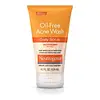What's inside
What's inside
 Key Ingredients
Key Ingredients

 Benefits
Benefits

 Concerns
Concerns

 Ingredients Side-by-side
Ingredients Side-by-side

Salicylic Acid 2%
MaskingWater
Skin ConditioningCetyl Alcohol
EmollientPPG-15 Stearyl Ether
EmollientPolyethylene
AbrasiveGlycolic Acid
BufferingGlycerin
HumectantPolysorbate 60
EmulsifyingSteareth-21
CleansingC12-15 Alkyl Lactate
EmollientCetyl Lactate
EmollientBHT
AntioxidantNeopentyl Glycol Dicaprylate/Dicaprate
EmollientCocamidopropyl Pg-Dimonium Chloride Phosphate
Potassium Cetyl Phosphate
EmulsifyingDisodium EDTA
Xanthan Gum
EmulsifyingSodium Benzotriazolyl Butylphenol Sulfonate
UV AbsorberSodium Hydroxide
BufferingAgar
MaskingMenthol
MaskingBenzalkonium Chloride
AntimicrobialCI 77492
Cosmetic ColorantMica
Cosmetic ColorantCI 16035
Cosmetic ColorantCI 15850
Cosmetic ColorantCI 19140
Cosmetic ColorantTitanium Dioxide
Cosmetic ColorantParfum
MaskingSalicylic Acid 2%, Water, Cetyl Alcohol, PPG-15 Stearyl Ether, Polyethylene, Glycolic Acid, Glycerin, Polysorbate 60, Steareth-21, C12-15 Alkyl Lactate, Cetyl Lactate, BHT, Neopentyl Glycol Dicaprylate/Dicaprate, Cocamidopropyl Pg-Dimonium Chloride Phosphate, Potassium Cetyl Phosphate, Disodium EDTA, Xanthan Gum, Sodium Benzotriazolyl Butylphenol Sulfonate, Sodium Hydroxide, Agar, Menthol, Benzalkonium Chloride, CI 77492, Mica, CI 16035, CI 15850, CI 19140, Titanium Dioxide, Parfum
Water
Skin ConditioningSodium C14-16 Olefin Sulfonate
CleansingPolylactic Acid
AbrasiveCocamidopropyl Hydroxysultaine
CleansingAcrylates Copolymer
Glycerin
HumectantMandelic Acid
AntimicrobialHamamelis Virginiana Water
AstringentCamphor
MaskingMentha Piperita Oil
MaskingPunica Granatum Fruit Extract
AntioxidantCamellia Sinensis Leaf Extract
AntimicrobialCymbopogon Schoenanthus Extract
Skin ConditioningEquisetum Arvense Extract
AstringentHumulus Lupulus Extract
AntimicrobialHydrastis Canadensis Extract
MaskingCaprylyl Glycol
EmollientPhenoxyethanol
PreservativeSodium Hydroxide
BufferingLinalool
PerfumingWater, Sodium C14-16 Olefin Sulfonate, Polylactic Acid, Cocamidopropyl Hydroxysultaine, Acrylates Copolymer, Glycerin, Mandelic Acid, Hamamelis Virginiana Water, Camphor, Mentha Piperita Oil, Punica Granatum Fruit Extract, Camellia Sinensis Leaf Extract, Cymbopogon Schoenanthus Extract, Equisetum Arvense Extract, Humulus Lupulus Extract, Hydrastis Canadensis Extract, Caprylyl Glycol, Phenoxyethanol, Sodium Hydroxide, Linalool
Ingredients Explained
These ingredients are found in both products.
Ingredients higher up in an ingredient list are typically present in a larger amount.
Glycerin is already naturally found in your skin. It helps moisturize and protect your skin.
A study from 2016 found glycerin to be more effective as a humectant than AHAs and hyaluronic acid.
As a humectant, it helps the skin stay hydrated by pulling moisture to your skin. The low molecular weight of glycerin allows it to pull moisture into the deeper layers of your skin.
Hydrated skin improves your skin barrier; Your skin barrier helps protect against irritants and bacteria.
Glycerin has also been found to have antimicrobial and antiviral properties. Due to these properties, glycerin is often used in wound and burn treatments.
In cosmetics, glycerin is usually derived from plants such as soybean or palm. However, it can also be sourced from animals, such as tallow or animal fat.
This ingredient is organic, colorless, odorless, and non-toxic.
Glycerin is the name for this ingredient in American English. British English uses Glycerol/Glycerine.
Learn more about GlycerinSodium Hydroxide is also known as lye or caustic soda. It is used to adjust the pH of products; many ingredients require a specific pH to be effective.
In small amounts, sodium hydroxide is considered safe to use. However, large amounts may cause chemical burns due to its high alkaline.
Your skin has a natural pH and acid mantle. This acid mantle helps prevent harmful bacteria from breaking through. The acid mantle also helps keep your skin hydrated.
"Alkaline" refers to a high pH level. A low pH level would be considered acidic.
Learn more about Sodium HydroxideWater. It's the most common cosmetic ingredient of all. You'll usually see it at the top of ingredient lists, meaning that it makes up the largest part of the product.
So why is it so popular? Water most often acts as a solvent - this means that it helps dissolve other ingredients into the formulation.
You'll also recognize water as that liquid we all need to stay alive. If you see this, drink a glass of water. Stay hydrated!
Learn more about Water